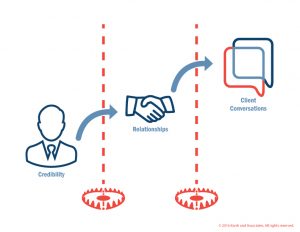— April 2, 2019
Working from a distance is becoming the new normal. As travel costs continue to rise and the search for talent is no longer limited by geography, more and more companies are turning to virtual teamwork for their everyday operations. Whereas working remotely used to be an exception, the number of employees who do so less than 20 percent of the time has decreased significantly in recent years.
But what differentiates the top-performing virtual teams from the weaker ones? Our research at OnPoint has uncovered several characteristics the most effective virtual teams share that set them apart from the rest.
5 Key Elements of Successful Virtual Teamwork
Trust
The foundation of effective virtual teams is trust. But building trust, especially when your team members are geographically dispersed and spontaneous interactions are infrequent and difficult to arrange, can be challenging. Trust is earned as the result of effort over time. When team members follow through on commitments and get to know each other on a more personal level they have more confidence that they can rely on others to do their part to achieve team goals.
Research has demonstrated that high levels of trust tend to translate into better team performance, especially when it comes to virtual teamwork. While colocated teams can rely on interpersonal relationships to build trust, effective virtual teams are more focused on task-based trust. As team members demonstrate accountability over time, they convince others that they can be relied upon to follow through on commitments and be responsible for completing assigned tasks.
Collaboration
Successful virtual teams have determined how to effectively collaborate across time and space. Using systems and processes to structure, support, and encourage team coordination, these teams work together and leverage everyone’s individual strengths to complete tasks and achieve desired results.
Software tools are especially helpful in facilitating virtual collaboration and remote teamwork. Project management software makes it possible to manage workflow transparently so everyone can see what other team members are working on and provide support when needed. Cloud-based platforms and other virtual team tools also foster collaboration by allowing multiple team members to work on the same project materials even when they’re located far from one another.
Motivation
Effective virtual team leaders keep their team focused and driven to reach their goals. They motivate members by finding ways to make everyone feel included, such as involving them in decision-making, showing them how their work is contributing to the larger picture, and recognizing and celebrating team achievements and successes.
By getting to know their team members and understanding their values, virtual leaders can motivate and inspire them more effectively. They can provide a sense of purpose for the team that empowers employees and helps them to align their personal goals with the team’s overall mission. Teams with engaged and motivated members consistently perform better than those with disengaged employees, which translates to better productivity, profitability, and retention.
Autonomy
Encouraging team members to assume responsibility not only motivates through heightened engagement, it also reinforces accountability. Effective delegation allows team members to show initiative and grab hold, making proactive choices and enhancing commitment to projects in the process. In addition, in a virtual world, meeting deadlines and quality standards is more important than when people actually do their work. Allowing people to organize their day and determine when and how work will be done, rather than “punching the clock,” is one component of motivating employees and promoting remote teamwork.
Establishing standardized work processes also helps virtual team members to function independently while still making positive contributions to team performance. Onboarding new members is easier when there are processes in place to manage workflow and highlight responsibilities. Without such systems, each member would have to endure a difficult (and inefficient) trial and error period to identify what strategies work best for completing tasks.
Communication
Because they are spread out and face-to-face interaction is rare, it is paramount that members of virtual teams keep the lines of communication wide open. The best virtual teams overcome the challenges geography offers through consistent contact. Feedback, accessibility, and timely responsiveness—not just from leadership down but among all members—keep operations running smoothly.
For quick and flexible interactions, virtual communication software is a much more practical (and personable) solution than email. Team members can interact and communicate in real time, allowing them to work together on complex projects even when they’ve never been in the same room together. Video conferencing is beneficial as well, encouraging team members to interact directly with one another on a regular basis. While face-to-face meetings are not always possible, team leaders should try to arrange one as part of a kick-off strategy or within the first few months of the team’s formation. These meetings help team members to form relationships and begin the process of building trust that will facilitate accountability and virtual collaboration.
Virtual teams have made it possible for organizations to better leverage their resources and perform work more efficiently than ever before. Simply assembling a virtual team, however, is no guarantee of success. Organizations with top-performing, effective virtual teams take great care when building these teams, selecting team members with the potential to thrive in a remote environment. Even with the best people in place, however, it still falls to virtual leaders to implement many of the aforementioned practices to ensure that their teams remain engaged, efficient, and productive.
Business & Finance Articles on Business 2 Community
(135)





